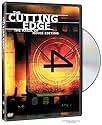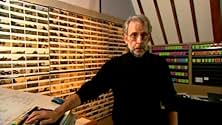AVALIAÇÃO DA IMDb
7,7/10
3,3 mil
SUA AVALIAÇÃO
Adicionar um enredo no seu idiomaDocumentary about the art of film editing. Clips are shown from many groundbreaking films with innovative editing styles.Documentary about the art of film editing. Clips are shown from many groundbreaking films with innovative editing styles.Documentary about the art of film editing. Clips are shown from many groundbreaking films with innovative editing styles.
Kathy Bates
- Narrator
- (narração)
Avaliações em destaque
Very fine feature length documentary lurking amidst the extras on my Bullitt Blu-ray disc. Little direct relevance to that film except that it did win an Oscar for editing and we do get to see some of the famous car chase. But never mind, all the better for not being directly related for this is a far reaching and informative piece. Kathy Bates narrates the early b/w footage and informs us that women were the first editors. It was considered somewhat related to sewing and stitching we are told and therefore appropriately relegated to ladies until sound came in and men had to be involved because that was far too technical. Before we have a chance to remonstrate we have Tarantino introducing his beloved editor Sally Menke and all is sweet and light. I had never seen Menke or fellow editors Walter Much, Craig McKay and others before and cannot even recall seeing Alexander Payne, Joe Dante or Lawrence Kasden, three of the numerous directors who also put in their pennies worth plus great little anecdotes. Informative, fast moving, colourful and of course, well edited.
In the 80's I watched a Hollywood how-it's-done film called "Scream Greats." It was the how-tos of horror. They showed many of the tricks for the blood, guts, and gore that I was sneaking to watch.
"Cutting Edge," I would say, is the partner to that film. To this point I had no idea what a film editor was. If I was given a hundred guesses I probably wouldn't have gotten it right. They are the people who piece the movie together from the thousands of frames of film. They have to cut, splice, intersplice, and more. Regardless of what order the movie is shot in, the editors can put it together to give the viewer the impression that it was one seamless and chronologically cohesive movie. If a movie incongruously jumps from one scene to the next, that's the editor. If a movie has seamless transitions from one scene to the next, that's the editor. "Cutting Edge" was some really fun and eye-opening stuff to watch.
"Cutting Edge" gives a history of the film editor, some of the most influential film editors, and the methodology of some current film editors. These hidden heroes are essential to the movie making process--probably as important as anybody--yet so unheralded. If "Cutting Edge" does anything it gives them at least a little bit of just due.
"Cutting Edge," I would say, is the partner to that film. To this point I had no idea what a film editor was. If I was given a hundred guesses I probably wouldn't have gotten it right. They are the people who piece the movie together from the thousands of frames of film. They have to cut, splice, intersplice, and more. Regardless of what order the movie is shot in, the editors can put it together to give the viewer the impression that it was one seamless and chronologically cohesive movie. If a movie incongruously jumps from one scene to the next, that's the editor. If a movie has seamless transitions from one scene to the next, that's the editor. "Cutting Edge" was some really fun and eye-opening stuff to watch.
"Cutting Edge" gives a history of the film editor, some of the most influential film editors, and the methodology of some current film editors. These hidden heroes are essential to the movie making process--probably as important as anybody--yet so unheralded. If "Cutting Edge" does anything it gives them at least a little bit of just due.
8donf
This is a remarkable documentary, informative, interesting and successful in clarifying what is, for many, something of a mysterious process. The contributions to film making of directors, actors, designers, cinematographers and sound recordists is self evident, but the film editor's role has seldom been understood nor its importance fully recognised. This documentary is the first to give directors and editors an opportunity to explain exactly what goes on in the editing room and they have done it superbly. What a pity then, that references to the history of film editing woven into this story are cursory, inadequate and in some instances completely wrong. Martin Scorsese refers to Edwin Porters' 1902 film, Life of an American Fireman, as the very first film to be edited using crosscutting as a structuring device, and the commentary supports this view, despite convincing evidence to the contrary that was discovered in 1978. In fact the earliest discovered examples of this practise date from 1906. Equally mistaken is the assertion, made several times in this prize-winning documentary, that D.W.Griffith originated the important editing practise of action matching. In fact there is clear evidence of action matching in a British film made as early as 1903 and Griffith's first film was not made until 1908. There is considerable evidence that Griffith considered action matching to be of very little importance, and when used in his films it is often ill judged and clumsy. All this is curious in a documentary that seeks to explain the history and practise of film editing. One might have expected research on the topic to be as well informed as the comments made by most of the contributors, particularly given that the scriptwriter is Professor Mark Jonathan Harris of the School of Cinema and Television, University of Southern California.
10lolique
I'm a film director/editor from Colombia with more than 45 years in the business and this film is absolutely the best essay on film editing that I've had the good luck of seeing. The examples are great, the explanations on the "unseen" or "hidden art" of editing are perfect, the pacing is just right, etc., etc. The only thing I felt was that it was too short, but then I'm biased on the subject. This should be a MUST SEE FILM for everybody starting out in the business (and not just those who want to be editors).This is a solid "10" for me and I can't understand how anybody would consider it less, except for those mediocre joes who just can't cut it...
This is one of the two feature-length documentaries on the 2-Disc Special Edition DVD of Bullitt. With a running time of 95 minutes, it is the longer one, by about 12 minutes. It consists of interviews and film clips(old, new, fiction, documentary(including propaganda works), famous and unknown, and a little real life footage; note that there are spoilers for many of the movies) used as examples or such, and narrated well by Kathy Bates. It is ironic that the invisibility and underrating of the role of the editor is somewhat shown by the fact that a couple of the directors here are actors first(big names, of the kind that draw attention), but other than that, I can say nothing negative about this. Everyone here has something to say(no, I know, I didn't expect much from Rob Cohen, the man behind xXx, either), and those who have the most to offer genuinely *are* the ones we see for the majority of this. Speaking as someone who *loves* the art of cutting, I can't say if this will be as compelling to those who aren't into the craft, however, this is clearly made for said group, and if you find yourself in it, you will not regret watching this. Before seeing this, I would not have dared suggest that one could successfully tell the history of its development and cover this amount of ground on the "theory" of it(like the line I quote in the summary, to give just one example) in a mere hour and a half. The whole thing is extremely interesting and informational. It has a great sense of humor without trying too hard. The numerous analogies and the like are excellent. As is fitting for the subject, this is put together rather well. There is a little strong language in this. I recommend this to anyone who wants to know more. 8/10
Você sabia?
- CuriosidadesThis documentary is featured on the Two-Disc Special Edition DVD for Bullitt (1968), released in 2005.
- Cenas durante ou pós-créditosEmbedded throughout the beginning of the credits are photos of several film editors displaying the awards that they've won.
- ConexõesFeatures O Regador Regado (1895)
Principais escolhas
Faça login para avaliar e ver a lista de recomendações personalizadas
- How long is The Cutting Edge: The Magic of Movie Editing?Fornecido pela Alexa
Detalhes
- Tempo de duração
- 1 h 39 min(99 min)
- Cor
- Mixagem de som
- Proporção
- 1.85 : 1
Contribua para esta página
Sugerir uma alteração ou adicionar conteúdo ausente


















